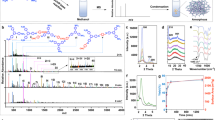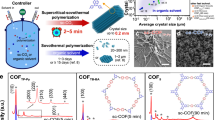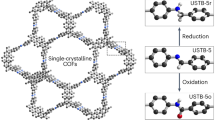Abstract
A core feature of covalent organic frameworks (COFs) is crystallinity, but current crystallization processes rely substantially on trial and error, chemical intuition and large-scale screening, which typically require harsh conditions and low levels of supersaturation, hampering the controlled synthesis of single-crystal COFs, particularly on large scales. Here we report a strategy to produce single-crystal imine-linked COFs in aqueous solutions under ambient conditions using amphiphilic amino-acid derivatives with long hydrophobic chains. We propose that these amphiphilic molecules self-assemble into micelles that serve as dynamic barriers to separate monomers in aqueous solution (nodes) and hydrophobic compartments of the micelles (linkers), thereby regulating the polymerization and crystallization processes. Disordered polyimines were obtained in the micelle, which were then converted into crystals in a step-by-step fashion. Five different three-dimensional COFs and a two-dimensional COF were obtained as single crystals on the gram scale, with yields of 92% and above.

This is a preview of subscription content, access via your institution
Access options
Access Nature and 54 other Nature Portfolio journals
Get Nature+, our best-value online-access subscription
$29.99 / 30 days
cancel any time
Subscribe to this journal
Receive 12 print issues and online access
$259.00 per year
only $21.58 per issue
Buy this article
- Purchase on Springer Link
- Instant access to full article PDF
Prices may be subject to local taxes which are calculated during checkout




Similar content being viewed by others
Data availability
All data supporting the findings of this study are available within the paper and its Supplementary Information files. Additionally, the X-ray crystallographic coordinates for the structures reported in this article have been deposited at the Cambridge Crystallographic Data Centre (CCDC), under deposition nos. CCDC 2049342 (C16-l-tLeuA), CCDC 2209466 (COF-301-S), CCDC 2049378 (SYSU-9-S) and CCDC 2245942 (COF-320). Copies of the data can be obtained free of charge via https://www.ccdc.cam.ac.uk/structures/. Source data are provided with this paper.
References
Diercks, C. S. & Yaghi, O. M. The atom, the molecule and the covalent organic framework. Science 355, eaal1585 (2017).
Côté, A. P. et al. Porous, crystalline, covalent organic frameworks. Science 310, 1166–1170 (2005).
Peng, L. et al. Ultra-fast single-crystal polymerization of large-sized covalent organic frameworks. Nat. Commun. 12, 5077 (2021).
Geng, K. Y. et al. Covalent organic frameworks: design, synthesis and functions. Chem. Rev. 120, 8814–8933 (2020).
Smith, B. J., Overholts, A. C., Hwang, N. & Dichtel, W. R. Insight into the crystallization of amorphous imine-linked polymer networks to 2D covalent organic frameworks. Chem. Commun. 52, 3690–3693 (2016).
Smith, B. J. & Dichtel, W. R. Mechanistic studies of 2D covalent organic frameworks rapidly polymerized from initially homogenous conditions. J. Am. Chem. Soc. 136, 8783–8789 (2014).
Ma, T. Q. et al. Single-crystal X-ray diffraction structures of covalent organic frameworks. Science 361, 48–52 (2018).
Evans, A. M. et al. Seeded growth of single-crystal two-dimensional covalent organic frameworks. Science 361, 52–57 (2018).
Lowenstam, H. A. Minerals formed by organisms. Science 211, 1126–1130 (1981).
Gower, L. B. et al. Biomimetic model systems for investigating the amorphous precursor pathway and its role in biomineralization. Chem. Rev. 108, 4551–4627 (2008).
Pal, A., Ghosh, Y. K. & Bhattacharya, S. Molecular mechanism of physical gelation of hydrocarbons by fatty acid amides of natural amino acids. Tetrahedron 63, 7334–7348 (2007).
Sakai, N. & Matile, S. Conjugated polyimine dynamers as phase-sensitive membrane probes. J. Am. Chem. Soc. 140, 11438–11443 (2018).
Li, Z. et al. Structural and dimensional transformations between covalent organic frameworks via linker exchange. Macromolecules 52, 1257–1265 (2019).
Pramudya, Y. & Mendoza-Cortes, J. L. Design principles for high H2 storage using chelation of abundant transition metals in covalent organic frameworks for 0–700 bar at 298 K. J. Am. Chem. Soc. 138, 15204–15213 (2016).
Pritula, I. & Sangwal, K. in Handbook of Crystal Growth: Bulk Crystal Growth 2nd edn (ed. Rudolph, P.) 1185–1227 (Elsevier, 2015).
Markov, I. V. Crystal Growth for Beginners: Fundamentals of Nucleation, Crystal Growth and Epitaxy (World Scientific, 2016).
Lovette, M. A. et al. Crystal shape engineering. Ind. Eng. Chem. Res. 47, 9812–9833 (2008).
Olafson et al. Early onset of kinetic roughening due to a finite step width in hematin crystallization. Phys. Rev. Lett. 119, 198101 (2017).
Zhan, G. L. et al. Observing polymerization in 2D dynamic covalent polymers. Nature 603, 835–840 (2022).
Kissel, P. et al. A nanoporous two-dimensional polymer by single-crystal-to-single-crystal photopolymerization. Nat. Chem. 6, 774–778 (2014).
Zhang, Y. B. et al. Single-crystal structure of a covalent organic framework. J. Am. Chem. Soc. 135, 16336–16339 (2013).
Feng, X. L. & Schlüter, A. D. Towards macroscopic crystalline 2D polymers. Angew. Chem. Int. Ed. 57, 13748–13763 (2018).
Ma, T. Q. et al. Observation of interpenetration isomerism in covalent organic frameworks. J. Am. Chem. Soc. 140, 6763–6766 (2018).
Zhao, W. et al. Using sound to synthesize covalent organic frameworks in water. Nat. Synth. 1, 87–95 (2022).
Lin, S. et al. Covalent organic frameworks comprising cobalt porphyrins for catalytic CO2 reduction in water. Science 349, 1208–1213 (2015).
Horike, S., Shimomura, S. & Kitagawa, S. Soft porous crystals. Nat. Chem. 1, 695–704 (2009).
Peng, Y. W. et al. Room temperature batch and continuous flow synthesis of water-stable covalent organic frameworks (COFs). Chem. Mater. 28, 5095–5101 (2016).
Acknowledgements
We acknowledge financial support from the National Natural Science Foundation of China (52061135103, 52173296, 21871009 and 22125102). The funders had no role in study design, data collection and analysis, decision to publish or preparation of the manuscript. Structure characterizations were supported by the Instrumental Analysis and Research Center of Sun Yat-sen University, the Institute of Chemistry, Chinese Academy of Sciences and the Diamond Light Source (Didcot, UK). We thank Y.N. Fan for access to powder XRD and FTIR, S.Y. Guan for access to NMR, X.H. Zhu for access to ESI-HRMS, and J. Li and S.A. Sapchenko for help with data collection of some materials.
Author information
Authors and Affiliations
Contributions
Z. Zheng initiated the project. Z. Zheng and W.L. coordinated the research. Z. Zheng and Z. Zhou designed the experiments. Z. Zhou performed most of the experimental work. L.Z., P.C. and J.S. performed continuous rotation electron diffraction and atomic structure analysis. Y.Y., Y.L. and F.T. helped with the synthesis. H.W., Y.Q. and X.D. carried out TEM and selected-area electron diffraction. L.G. and Z.L. conducted AFM. I.J.V.-Y. and S.Y. conducted synchrotron radiation single-crystal XRD. Y.H. and X.D. helped with the PXRD analysis. P.C. carried out the high-resolution PXRD measurements. J.Y. and C.W. performed N2 and CO2 adsorption–desorption experiments. Z. Zheng, Z. Zhou, J.S., L.Z., W.L. and H.Q. wrote the paper. All authors contributed to the proofreading of the paper.
Corresponding authors
Ethics declarations
Competing interests
The authors declare no competing interests.
Peer review
Peer review information
Nature Chemistry thanks Long Chen, Kian Ping Loh and the other, anonymous, reviewer(s) for their contribution to the peer review of this work.
Additional information
Publisher’s note Springer Nature remains neutral with regard to jurisdictional claims in published maps and institutional affiliations.
Extended data
Extended Data Fig. 1 The structure and size of C16-GlyA micelle.
a, Left, the Dynamic light scattering (DLS) number-average size of the assembled C16-GlyA, C16-GlyA + TAM (TAM without protonation) and C16-GlyA + linker-A; right, photographs of the solutions are shown. b, Structure of C16-L-tLeuA by single-crystal XRD. c, The DLS number-average size of the assembled glycine derivative with different aliphatic chain lengths (bottom), and photographs of the samples.
Extended Data Fig. 2 Monomers dissolved in water or micelle.
a, 1H-NMR of the aqueous phase after adding P-toluenesulfonic acid (PTSA) protonated TAM to aqueous solution of C16-GlyA. b, 1H-NMR of the aqueous phase after adding TAM powder. TAM was not detected in the aqueous phase. c, ESI-HRMS of oil phase after adding linker-A to aqueous solution of C16-GlyA.
Extended Data Fig. 3 Polymerization and crystallization process monitored by different techniques.
a, b, TEM (a) and SAED (b) images of amorphous precursors before the formation of crystals of COF-301. Powder XRD patterns (c) and full width at half maxima (FWHM) of (2 0 0) (d) of solid products separated from the reaction system at different reaction times. e, Infrared spectra of TAM, linker-A, COF-301 and product with a reaction time of 10 minutes. f, Confocal Raman spectroscopy of COF-301, C16-GlyA and COF-301-S.
Extended Data Fig. 4 Effects of amphiphilic molecules on the crystallization of COF-301.
a, The yield and crystallinity (using the intensities of Bragg peaks) of COF-301 obtained from glycine derivatives with different aliphatic chain lengths. b, COF-301 synthesized using palmitic acid in water under ambient conditions. c, Optical images of COF-301 synthesized using different amino acid derivatives in water under ambient conditions.
Extended Data Fig. 5 The dependence of the yield, crystallinity and reaction time of the synthesized COF-301 on the added molar equivalent of PTSA to TAM.
The dependence of the yield, crystallinity and reaction time of the synthesized COF-301 on the added molar equivalent of PTSA to TAM.
Extended Data Fig. 6 Effects of temperature and cationic ions on crystallization of COF-301.
a, The effects of different acids on the yield and crystallinity of products (using the intensities of Bragg peaks). Optical microscopy images of COF-301 using C16-GlyA in water under 25 °C (b) and 75 °C (c). Optical microscopy images of COF-301 under LiOH (d) and KOH (e).
Extended Data Fig. 7 Morphology of COF-300, COF-320 and COF-TTA-BTA.
a, b, Optical images of COF-300/320 c, TEM images of COF-TTA-BTA.
Extended Data Fig. 8 The size, morphology and processability of COF-310, COF-300 and 2DCOF-TTA-BTA.
a, The DLS number-average size of COF-310, COF-300 and 2DCOF-TTA-BTA in water. b, Photographic image of COF-310, COF-300 and 2DCOF-TTA-BTA in water. c, d, Membranes formed by suction filtration of COF-300 (0.6 µm) (c) and 2DCOF-TTA-BTA (d), respectively. Atomic force microscopy (AFM) image of 2DCOF-TTA-BTA (e) after ultrasonic peeling, and corresponding HRTEM images (f).
Extended Data Fig. 9 N2 adsorption isotherm.
a, b, N2 adsorption isotherm of COF-300 (a) and COF-TTA-BTA (b) at 77 K.
Extended Data Fig. 10 Structure of COF-366.
a, b, TEM image (a) and selected area electron diffraction (b) of the COF-366 obtained at the air-water interface using C16-L-tLeuA on the first day. c–g, TEM images of COF-366 synthesized at the air-water interface using C16-L-tLeuA on the seventh day (c). Selected area electron diffraction at different areas (1 (d), 2 (e), 3 (f), 4(g)) indicated the single crystallinity of the crystal. h, Left, Near-atomic structure observation of COF-366 by aberration-corrected high-resolution TEM. Right, corresponding Fast Fourier transform (FFT) pattern.
Supplementary information
Supplementary Information
Supplementary Materials and Methods, Figs. 1–42, Discussion and Tables 1–11.
Supplementary Data 1
CIF file for C16-L-tTeuA obtained from single-crystal XRD.
Supplementary Data 2
CIF file for COF-301-S obtained from single-crystal XRD.
Supplementary Data 3
CIF file for COF-301-W obtained by Rietveld refinement of powder diffraction.
Supplementary Data 4
CIF file for COF-300 obtained by Rietveld refinement of powder diffraction.
Supplementary Data 5
CIF file for SYSU-8 obtained by Rietveld refinement of powder diffraction.
Supplementary Data 6
CIF file for SYSU-9-S obtained from single-crystal XRD.
Supplementary Data 7
CIF file for SYSU-9-W obtained by Rietveld refinement of powder diffraction.
Supplementary Data 8
CIF file for COF-320 obtained by continuous rotation electron diffraction.
Supplementary Data 9
CIF file for 2DCOF-TTA-BTA obtained by Rietveld refinement of powder diffraction.
Supplementary Data 10
Source data files for data presented in graphs within Supplementary Fig. 37.
Source data
Source Data Fig. 2
Source data files for data presented in graphs within Fig. 2b.
Source Data Extended Data Fig. 1
Source data files for data presented in graphs within panels a, left, and c, bottom.
Source Data Extended Data Fig. 2
Source data files for data presented in graphs within Extended Data Fig. 3d.
Source Data Extended Data Fig. 4
Source data files for data presented in graphs within Extended Data Fig. 4a, bottom right.
Source Data Extended Data Fig. 5
Source data files for data presented in graphs within Extended Data Fig. 5, bottom right.
Source Data Extended Data Fig. 6
Source data files for data presented in graphs within Extended Data Fig. 6a, top right.
Source Data Extended Data Fig. 8
Source data files for data presented in graphs within Extended Data Fig. 8a.
Rights and permissions
Springer Nature or its licensor (e.g. a society or other partner) holds exclusive rights to this article under a publishing agreement with the author(s) or other rightsholder(s); author self-archiving of the accepted manuscript version of this article is solely governed by the terms of such publishing agreement and applicable law.
About this article
Cite this article
Zhou, Z., Zhang, L., Yang, Y. et al. Growth of single-crystal imine-linked covalent organic frameworks using amphiphilic amino-acid derivatives in water. Nat. Chem. 15, 841–847 (2023). https://doi.org/10.1038/s41557-023-01181-6
Received:
Accepted:
Published:
Issue Date:
DOI: https://doi.org/10.1038/s41557-023-01181-6
This article is cited by
-
Encoding ordered structural complexity to covalent organic frameworks
Nature Communications (2024)
-
Non-classical crystallization in soft and organic materials
Nature Reviews Materials (2024)
-
Amphiphilic amino-acid derivatives promote gram-scale single-crystal COFs synthesis
Science China Chemistry (2024)
-
Structural tailoring of covalent organic frameworks with steric effects
Science China Chemistry (2023)



